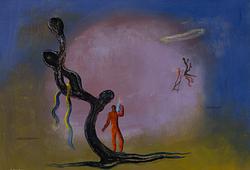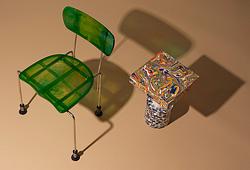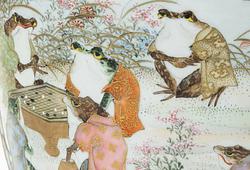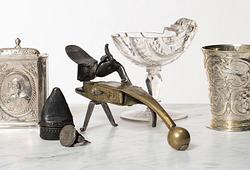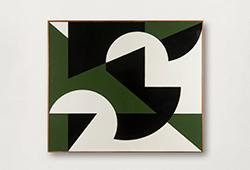Jan Håfström
"The Brothers"
Signed Jan Håfström and dated 2002. Acrylic on panel 120 x 120 cm.
Alkuperä - Provenienssi
Galleri Brändström & Stene, Stockholm.
Dan-Ola and Ann Christine Larsson Collection.
Kirjallisuus
Dunkers Kulturhus, ed E. Lidman och M. Jensner, "Nattens Industri, Jan Håfström", 2002, illustrated fullpage p. 13.
Martin Sundberg (ed.), 'Tillvaratagna effekter (Reclaimed properties)', 2005, illustrated on the cover, also illustrated p. 307, and details illustrated on p. 306, 308, 315.
Thomas Millroth och Filippa Arrias, "KONSTEN - en del av livet, Dan-Ola och Ann Christine Larsson", 2016, illustrated fullpage p. 63.
Muut tiedot
In the piece "Bröderna" one has to assume that it is Daniel Defoe’s Robinson Crusoe and Friday who are about to set off in the canoe and leave the deserted island behind. It has been said that the Robinson character is in fact the artist, and the facial features give some credibility to this claim. Håfström considers himself an outsider and in the painting in the auction, "Bröderna", he emphasises this by appearing through a telescopic sight as Robinson. There is a connection here, in the circular detail of the sight, to one of his earlier paintings, "Den hemlighetsfulla ön" from 1965. Both paintings depict male worlds and men being alone on islands. This is no coincidence as Håfström’s practice often references his own earlier work.
Martin Sundberg describes "Bröderna", the painting in the auction, in his major text on the artist, "Tillvaratagna Effekter", as follows:
“Attention is directed towards him (Håfström) and his project. At the same time he finds himself in a world (light), divorced from the surroundings (dark). Those on the outside stand there baffled, but the artist won’t be influenced in his project to create and pull the whole thing off. The melancholic artist observes, but is not completely powerless to act. He is defined by a basic need to communicate.”
Sundberg continues:
“That his artistic practice (Håfström’s) also includes the joy of creativity, so striking in his desire to paint, is visible in "Bröderna". The men have carved a canoe and are now physically working on launching it to sea. What’s more, the vessel becomes a metaphor not only for his practice, but also for the attempt, by creating, to survive. Additionally, the canoe implies an imminent journey, a recurring metaphor for creativity not only in Håfström’s work…”
Jan Håfström is an important player on the Swedish cultural and literary scene. Despite being 84 years old he remains active and always relevant. Only recently he showed new work with Galleri Andersson/Sandström at the Market Art Fair in September 2021.
Taiteilija
Ever since the 60s, Jan Håfström has been an important and clearly shining star in Swedish art and culture. He graduated from the Academy of Fine Arts in Stockholm and painted "The Forest", 1968 and later "Grandmother", 1972, both of which have become classics and can be seen in the Moderna Museet's collection.
In 2001, he surprised the Swedish art public with the exhibition "Walker", at Färgfabriken in Stockholm. Out of the abstract, quiet, minimalist comes Mr. Walker and his fictitious, eventful world. Elements of childhood adventures and images depicting the disguised Mr. Walker aka the Phantom are in the paintings. This time in the form of cut-out, enlarged details. Like scenery that for once has the main role, the stories and adventures return in fragments and form a new story, about how it was and how it came to be. But Walker also moves in the same world as A. Böcklin's "Island of Death" 1880s and Joseph Conrad's "Heart of Darkness" from 1902. In the darkness of romance, death is fought and the creative power of life is allowed to win and triumph. In the story about Walker, Håfström combines the abstract canvases and the moods of the objects with the stories that were decisive and strongly influenced his life. The journey of childhood comes back in stripped down and renewed form.
Lue lisää



